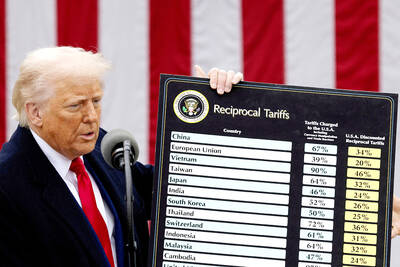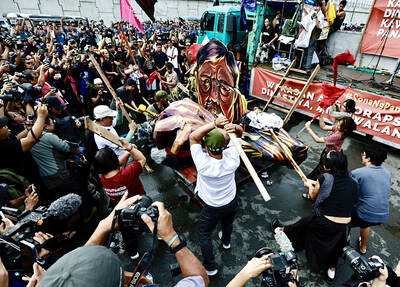One of India’s largest outsourcing companies yesterday struggled to retain an air of normalcy as the business community reeled from the news that the company chairman had been doctoring the books for years.
The whereabouts of chairman B. Ramalinga Raju, who quit on Wednesday after admitting that the company’s balance sheets were riddled with “fictitious” assets and “nonexistent” cash, were unclear, company spokeswoman Archana Uttapa said.
Trading on India’s stock exchanges was closed yesterday because of a holiday, but on Wednesday, news of the fraud by Satyam Computer Services Ltd dragged down the benchmark SENSEX stock index 7.3 percent — with Satyam’s shares plummeting nearly 78 percent.
Media reports have said that officials with the Securities and Exchange Board of India, which is investigating the incident, were traveling to the firm’s headquarters in Hyderabad, in southern India. But Uttapa said she was unaware that any such visit was planned.
Uttapa also sought to downplay Indian media reports saying many Satyam employees were worried about their jobs and getting their resumes ready.
“There is no concerted move by employees to quit and find new jobs as of now,” she said.
“All Satyam offices are open and working as normal,” she said.
The scandal, though, could ripple far beyond the Satyam offices.
“Much more than the fate of one company and its investors is at stake here, the scandal could taint the entire edifice of outsourcing,” the Hindustan Times, one of India’s most widely read newspapers, said in an editorial.
“This is a home-grown disaster,” the Indian Express said.
Satyam employs 53,000 people — among the 2 million Indians working in the country’s booming high-tech industry, which last year brought in an estimated US$40 billion.
While the accounting scandal raises questions about the quality of corporate governance in India, there were also plenty of comparisons to the collapse of the US energy giant Enron Corp.
“India’s strength in recent years has been its ability to produce great companies, and allowing that reputation to fall by the wayside is not in anyone’s interest,” the Indian Express continued, adding that Enron’s failure came in an economy more regulated than India’s.
US energy giant Enron collapsed in 2001 after revelations that bosses hid company losses and hyped the stock’s value while selling their own shares on the sly, leading to prosecutions.
Auditors Arthur Andersen were also convicted after allegations that employees shredded documents to hide evidence relating to the scandal.
Satyam’s balance sheet contained a US$1 billion hole that could no longer be concealed after a deal intended to save the struggling company was abandoned, Raju said in a letter to the board on Wednesday.
Raju said that none of the other board members was aware of the firm’s actual financial situation and that no one had profited from the inflated results.

Rainfall is expected to become more widespread and persistent across central and southern Taiwan over the next few days, with the effects of the weather patterns becoming most prominent between last night and tomorrow, the Central Weather Administration (CWA) said yesterday. Independent meteorologist Daniel Wu (吳德榮) said that based on the latest forecast models of the combination of a low-pressure system and southwesterly winds, rainfall and flooding are expected to continue in central and southern Taiwan from today to Sunday. The CWA also warned of flash floods, thunder and lightning, and strong gusts in these areas, as well as landslides and fallen

WAITING GAME: The US has so far only offered a ‘best rate tariff,’ which officials assume is about 15 percent, the same as Japan, a person familiar with the matter said Taiwan and the US have completed “technical consultations” regarding tariffs and a finalized rate is expected to be released soon, Executive Yuan spokeswoman Michelle Lee (李慧芝) told a news conference yesterday, as a 90-day pause on US President Donald Trump’s “reciprocal” tariffs is set to expire today. The two countries have reached a “certain degree of consensus” on issues such as tariffs, nontariff trade barriers, trade facilitation, supply chain resilience and economic security, Lee said. They also discussed opportunities for cooperation, investment and procurement, she said. A joint statement is still being negotiated and would be released once the US government has made

SOUTH CHINA SEA? The Philippine president spoke of adding more classrooms and power plants, while skipping tensions with China over disputed areas Philippine President Ferdinand Marcos Jr yesterday blasted “useless and crumbling” flood control projects in a state of the nation address that focused on domestic issues after a months-long feud with his vice president. Addressing a joint session of congress after days of rain that left at least 31 dead, Marcos repeated his recent warning that the nation faced a climate change-driven “new normal,” while pledging to investigate publicly funded projects that had failed. “Let’s not pretend, the people know that these projects can breed corruption. Kickbacks ... for the boys,” he said, citing houses that were “swept away” by the floods. “Someone has

‘CRUDE’: The potential countermeasure is in response to South Africa renaming Taiwan’s representative offices and the insistence that it move out of Pretoria Taiwan is considering banning exports of semiconductors to South Africa after the latter unilaterally downgraded and changed the names of Taiwan’s two representative offices, the Ministry of Foreign Affairs (MOFA) said yesterday. On Monday last week, the South African Department of International Relations and Cooperation unilaterally released a statement saying that, as of April 1, the Taipei Liaison Offices in Pretoria and Cape Town had been renamed the “Taipei Commercial Office in Johannesburg” and the “Taipei Commercial Office in Cape Town.” Citing UN General Assembly Resolution 2758, it said that South Africa “recognizes the People’s Republic of China (PRC) as the sole